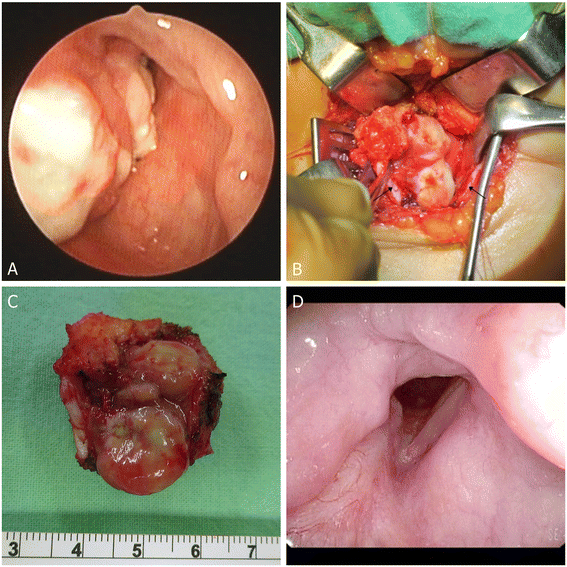Obstructive laryngeal schwannoma in a young female
- PMID: 25889574
- PMCID: PMC4332926
- DOI: 10.1186/s12957-014-0433-1
Obstructive laryngeal schwannoma in a young female
Abstract
Laryngeal schwannomas are rare, benign neurogenic tumors. They normally present as a slow-growing, encapsulated, submucosal mass in the supraglottic region. We describe a 20-year-old female presenting with a 2-year history of hoarseness and progressive worsening dyspnea. Fiberoptic laryngoscopy and computed tomography revealed a round, low-density submucosal mass at right false cord and arytenoepiglottic regions with glottic extension. Microlaryngoscopic biopsy and debulking for this solid tumor were performed without tracheostomy. Schwannoma was confirmed by histopathological study. However, rapidly worsening stridor occurred 2 weeks after the surgery. Fiberoptic laryngoscopy showed an exophytic tumor occupying the right hemilarynx with airway compromise. Definite complete excision of the tumor was performed by right vertical hemilaryngectomy. At 5-month follow-up, the laryngeal wound was clear without signs of recurrence. Rapid occurrence of airway obstruction after debulking and biopsy was demonstrated in this case. Vertical hemilaryngectomy was inevitable to cure this potentially life-threatening laryngeal schwannoma in this young female with postoperative serviceable voice.
Figures




Similar articles
-
Paraglottic space schwannoma: a case report and literature review.J Int Med Res. 2022 Sep;50(9):3000605221122497. doi: 10.1177/03000605221122497. J Int Med Res. 2022. PMID: 36113014 Free PMC article. Review.
-
Laryngeal Schwannoma, Alarming Mass of Airway: A Case Report.JNMA J Nepal Med Assoc. 2021 Nov 15;59(243):1185-1188. doi: 10.31729/jnma.6345. JNMA J Nepal Med Assoc. 2021. PMID: 35199768 Free PMC article.
-
Laryngeal schwannoma with extralaryngeal extension.Auris Nasus Larynx. 2012 Jun;39(3):317-20. doi: 10.1016/j.anl.2011.07.010. Epub 2011 Aug 20. Auris Nasus Larynx. 2012. PMID: 21862263
-
Laryngeal schwannoma: A case report and literature review.Ear Nose Throat J. 2024 Sep;103(9):NP537-NP540. doi: 10.1177/01455613221075225. Epub 2022 Jan 29. Ear Nose Throat J. 2024. PMID: 35098768 Review.
-
Laryngeal Schwannoma: A Case Presentation and Review of the Mayo Clinic Experience.J Voice. 2017 Jan;31(1):129.e15-129.e18. doi: 10.1016/j.jvoice.2015.12.003. Epub 2016 Jan 18. J Voice. 2017. PMID: 26795969
Cited by
-
Transoral Endoscopic-Assisted Resection of Laryngeal Schwannoma: A Case Report.Iran J Otorhinolaryngol. 2024 Jan;36(1):371-375. doi: 10.22038/IJORL.2023.71324.3427. Iran J Otorhinolaryngol. 2024. PMID: 38259691 Free PMC article.
-
Supraglottic Schwannoma: Dilemma and Challenges in Management.Indian J Otolaryngol Head Neck Surg. 2022 Dec;74(Suppl 3):5172-5176. doi: 10.1007/s12070-021-03027-4. Epub 2022 Jan 12. Indian J Otolaryngol Head Neck Surg. 2022. PMID: 36742766 Free PMC article.
-
Laryngeal schwannoma as an acute airway presentation.BMJ Case Rep. 2016 Mar 11;2016:bcr2016214682. doi: 10.1136/bcr-2016-214682. BMJ Case Rep. 2016. PMID: 26969364 Free PMC article. Review.
-
Paraglottic space schwannoma: a case report and literature review.J Int Med Res. 2022 Sep;50(9):3000605221122497. doi: 10.1177/03000605221122497. J Int Med Res. 2022. PMID: 36113014 Free PMC article. Review.
-
Laryngeal schwannoma: a systematic review.Eur Arch Otorhinolaryngol. 2017 Jan;274(1):25-34. doi: 10.1007/s00405-016-4013-6. Epub 2016 Mar 28. Eur Arch Otorhinolaryngol. 2017. PMID: 27020268
References
-
- Verocay J. Multiple Geschwülste als Systemerkrankung am nervösen. Germany: W Braunmüller; 1908.
-
- Jones SR, Myers EN, Barnes L. Benign neoplasms of the larynx. Otolaryngol Clin North Am. 1984;17:151–78. - PubMed
Publication types
MeSH terms
LinkOut - more resources
Full Text Sources
Other Literature Sources

